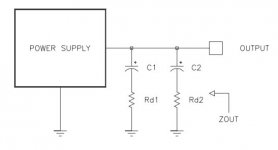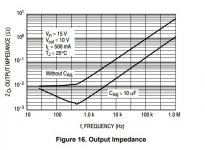I have one small issue with the LT1963, apart from it being quite a bit more expensive than a LM317.
It is limited to max. Vin of 20V.
If you use a 15Vac transformer secondary, you might well exceed that at no load.
Which essentially means you need to add a pre-reg, e.g. a LM7820.
This adds cost and complexity.
Patrick
It is limited to max. Vin of 20V.
If you use a 15Vac transformer secondary, you might well exceed that at no load.
Which essentially means you need to add a pre-reg, e.g. a LM7820.
This adds cost and complexity.
Patrick
Well, unfortunately my time ain't worth much these days, as I am an old retired fart. My lowly LM4562-powered line-level circuits have a PSRR of 120 db. I am not in the class of Armani suits or Borbely line amps. The LT1963 regulator kits I found were as expensive as the Jung-Didden ones, so....???How much is your time worth. Would you buy an Armani suit and put on dirty trow underneath? Fortunately, you can hear the difference -- at least we could when all the regulators shown in the graph were used to power the Borbely All-JFET Line Amp. Mind you, the Borbely pre, very low noise and vanishingly low THD, only has 40dB of PSRR so any problem on the supply rails makes itself manifest when it gets to your ears! The error amplifier of the LM317/LM337 is slow by comparison, the result being harmonics impinging upon the supply rails. If I had to use an off-the-shelf OEM regulator I would prefer the LT1963A.
Build your own using low noise components on a Vero board :
Voltage Regulator From Discrete Components
Patrick
Voltage Regulator From Discrete Components
Patrick
Why is noise at 10MHz relevant for audio?
It's a common way many power supplies are specified and measured. We are talking about power supplies aren't we? Interestingly most scopes have a 10Mhz button you can reduce their BW to. Not that a scope is a reliable way to measure this.
edit> A single PARD number is useful when comparing supplies. Sadly many op-amps and Vreferences don't have a standard when it comes to noise.
Last edited:
Please don't use common sense; it has a tendency to cause panic in the forum. 😀
Audiophiles and common sense now that is a joke.
Ultra LN power supply design is interesting but is overkill for 90% modern audio circuits barring weird audiophile amp designs.. no disrespect meant.
Last edited:
This is a DIY forum.
People do this for fun, as they do for any hobby.
Ultra LN powers supply design is A LOT OF fun.
🙂
Patrick
People do this for fun, as they do for any hobby.
Ultra LN powers supply design is A LOT OF fun.
🙂
Patrick
For my project a tiny 16W amp + hetadphone amp, I try both LM317 and Sulzer regulator, to be honest, I think LM317 sounds better, even though Sulzer has lower noise floor. But in my system it's not audible for both setup.
In my amp, the noise is dominated by amp itself with is not audible, power supply didn't contribute much at all, but I have to say it helps a lot when I use it in my other not so well calculated design.
Just I don't understand why simple LM317 sounds better.
In my amp, the noise is dominated by amp itself with is not audible, power supply didn't contribute much at all, but I have to say it helps a lot when I use it in my other not so well calculated design.
Just I don't understand why simple LM317 sounds better.
Last edited:
Low noise
If you looking for low noise stick with the ancient uA723 regulator.
The LM-723 has an output noise voltage of ( BW = 100 Hz to 10 kHz, CREF = 5 μF ) 2.5 μVrms
Way better than most modern regulators.
If you looking for low noise stick with the ancient uA723 regulator.
The LM-723 has an output noise voltage of ( BW = 100 Hz to 10 kHz, CREF = 5 μF ) 2.5 μVrms
Way better than most modern regulators.
LT3045 is 0.8µVrms 10Hz to 100kHz (instead of 100Hz to 10kHz).
http://cds.linear.com/docs/en/datasheet/3045fa.pdf
But of course noise is only one performance criterion for a regulator.
Patrick
http://cds.linear.com/docs/en/datasheet/3045fa.pdf
But of course noise is only one performance criterion for a regulator.
Patrick
If you looking for low noise stick with the ancient uA723 regulator.
The LM-723 has an output noise voltage of ( BW = 100 Hz to 10 kHz, CREF = 5 μF ) 2.5 μVrms
Way better than most modern regulators.
I remember reading Horowitz & Hill 2nd ed. gave it an honorable mention, perhaps in their analog LN Vref section. HP (Harrison Labs) in the 60's used a 6.2 zener on all their lab supplies, for the specs I quoted above. In which I believe a uA723* never had a chance of meeting..on Astron supplies (text book design) anyways. The error amp it sucked compared to a dual 200Mz bipolar and dedicated discrete driver stage..
Last edited:
LT3045 is 0.8µVrms 10Hz to 100kHz (instead of 100Hz to 10kHz).
http://cds.linear.com/docs/en/datasheet/3045fa.pdf
But of course noise is only one performance criterion for a regulator.
Patrick
but have you built and tested one?
hmm talking about load caps, 10uF ceramic X7R might set you back sum.
Anything that claims RF VCO in their sales intro (data sheet) is bound to be down there.
Too bad Jim Williams never used it his noise test jigs to replace his D cells.
Last edited:
So, if my opamp of choice is an LM4562 with a PSRR of -120 db; then I should not be able to hear this difference, eh?Fortunately, you can hear the difference -- at least we could when all the regulators shown in the graph were used to power the Borbely All-JFET Line Amp. Mind you, the Borbely pre, very low noise and vanishingly low THD, only has 40dB of PSRR so any problem on the supply rails makes itself manifest when it gets to your ears! The error amplifier of the LM317/LM337 is slow by comparison, the result being harmonics impinging upon the supply rails. If I had to use an off-the-shelf OEM regulator I would prefer the LT1963A.
I forgotToo bad Jim Williams never used it his noise test jigs to replace his D cells.
Batteries are still needed to prevent ground loops or from AC leakage into the ground/s.
Single earth ground at the entry to the AC RMS meter tied to his double steel cookie housings. I know measuring 1mV noise signals is tricky, so I can imagine grasping with uV is challenging / impossible with mains powered pre-amps.
Biggest cap is not the solution, right cap is...that's what's described in this interesting paper
I read the paper few times, indeed very interesting. But I find it hard to implemented numbers on the charts. What would be your practical suggestion for C1/Rd1, C2/Rd2 on LM317 application to lower high frequency impedance?
Attachments
The Rd's are the dissipation losses of the capacitors, modeled as resistance which are a function of frequency.I read the paper few times, indeed very interesting. But I find it hard to implemented numbers on the charts. What would be your practical suggestion for C1/Rd1, C2/Rd2 on LM317 application to lower high frequency impedance?
Depending on what you mean by 'high frequency' to get low impedance I would add some ceramic capacitors for MHz or perhaps smaller electrolytics for high kHz. You may want these close to the load rather than the reg.
Why would a power supply have noise at 20 Hz?If your power supply only has noise at 20Hz, yes.
🙂Patrick
The Rd's are the dissipation losses of the capacitors, modeled as resistance which are a function of frequency.
Depending on what you mean by 'high frequency' to get low impedance I would add some ceramic capacitors for MHz or perhaps smaller electrolytics for high kHz. You may want these close to the load rather than the reg.
Thank you for your answer, I'm talking about this paper
http://www.diyaudio.com/forums/atta...r-supply-frequency-impedance-improvements-pdf
In it, it said 3 terminal regulator's output impedance you can simplified to some RL, R network, that's why when the output capacitor's esr is too small it will cause ringing or oscillation.
I don't really understand how to do the calculation for choosing right output capacitor according to the article, so the Rd in this case, could be the esr or extra resistor added.
One simple question, If I put decouple capacitor in op amp, then I don't need any output capacitor from LM317 if the distance is close enough, is that what you mean?
Attachments
- Home
- Amplifiers
- Power Supplies
- LM317 load capacitance

